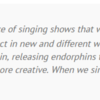The science is in. Singing is really, really good for you and the most recent research suggests that group singing is the most exhilarating and transformative of all.
The research suggests that creating music together evolved as a tool of social living. Groups and tribes sang and danced together to build loyalty, transmit vital information and ward off enemies.
 What has not been understood until recently is that singing in groups triggers the communal release of serotonin and oxytocin, the bonding hormone, and even synchronises our heart beats.
What has not been understood until recently is that singing in groups triggers the communal release of serotonin and oxytocin, the bonding hormone, and even synchronises our heart beats.
For a decade, science has been hard at work trying to explain why singing has such a calming yet energising effect on people. Numerous studies demonstrate that singing releases endorphins and oxytocin – which in turn relieve anxiety and stress and which are linked to feelings of trust and bonding.
To read more of Cassandra Sheppard's article, please click here.
Words by Cassandra Sheppard:
Passionate community development worker who has lived and worked in Asia and Africa and created a thriving grass roots community centre in Democratic Republic of Congo.





Comments (0)